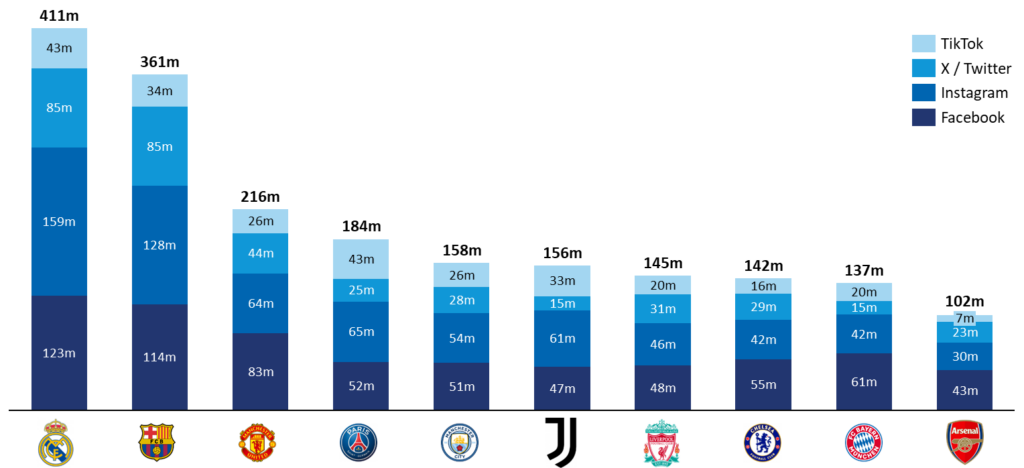
What does it mean to be a fan of a football club? For many, the litmus test is whether or not you watch the club’s matches – if not from inside the stadium itself, then the next best thing. Indeed, every weekend, fans of the world’s top clubs take to their TV screens in their millions to watch their beloved team take on fresh opposition for the next 90 minutes. This widespread demand explains the astronomical price-tags attached to packages for broadcasting rights among the world’s most popular leagues – see the latest 5-year Premier League broadcasting rights deal for £6.7bn.
However, there is more than one way to skin a cat. A modern fan can engage with their sports club in many different ways, from social media to mobile apps and beyond. In this article, we discuss the digital perspective. How do sports rights holders – that’s clubs, leagues, governing bodies, etc. – use the digital world to engage with their fanbases? And are new ways of engagement on course to become more popular than simply watching the games?
How big are the followings?
One of the biggest differences between sports clubs of today versus those of decades gone by is the extent of the clubs’ ability to communicate directly with their fans. Previously limited to announcements aired on TV and radio broadcasts or published in traditional print media, sports clubs can now address their global fanbases without the intermediary of a TV exec or a sports news editor.
According to a report from the Football Observatory, there are 18 football clubs in the world with more than 50 million combined followers across Facebook, Instagram, Twitter / X, and TikTok. Real Madrid and FC Barcelona alone have over 750 million followers between them across all platforms.
Of course, this number is inflated beyond the individual follower count because of the overlap between platforms; in many cases, the same fan will be among their club’s followership on more than one platform. But the point stands: the audiences reachable via social media for the world’s biggest football clubs are enormous and unprecedented. The same is true, albeit to a much lesser extent, for smaller clubs, in football and beyond.

But what is it used for?
So social media enables sports clubs to adopt a direct-to-fan approach to engagement. But simply having the audience does not yield much fruit from the clubs’ perspective. They need fans to engage, interact, like, and share. These are the metrics that ultimately drive revenues for rights holders. So how do they boost these numbers?
Exclusivity and FOMO
First: exclusive access. Social media pages of sports clubs often provide exclusive behind- the-scenes (BTS) footage and updates that are inaccessible via traditional viewing channels. This creates a sense of privilege and exclusivity, as well as boosting an age-old marketing strategy: the fear of missing out.
Positive Engagement Loops
Many clubs also offer interactive content, such as quizzes, polls, and player Q&A sessions. Fans are encouraged to engage directly with this form of content, which in turn enables clubs to engage back with the fans, typically by replying to popular comments or reposting viral fan videos.
Fan-centric campaigns highlighting individual fan stories and contributions, as well as real- time content such as updates, live scores, and highlights, are other popular means of using social media for sports clubs.
For sports clubs today, every piece of published content is a chance to engage millions of fans – perfectly illustrated by Wigan Athletic’s timely hop on to the viral “Barclaysmen” trend. There is a clear business case for clubs to prioritise their digital engagement.

Hugo Rodallega and co.: Defining “Barclaysmen”
Social media is not the only way for fans to digitally engage. Indeed, it is typically not where the most engaged fans spend their time. Instead, clubs are increasingly investing in dedicated mobile apps, offering fans a one-stop shop for the digital fan experience.
What is driving clubs to adopt these platforms?
The desire for data
One of the benefits provided by these platforms – usually as branded as “Official [Club] App” – is a more seamless user experience, where fans can buy tickets, follow recent updates, and purchase Club memorabilia all in one place.
However, the major benefit from the clubs’ standpoint lies elsewhere: first-party data. By offering such a wide range of features all on the same proprietary platform, clubs can gather vast numbers of datapoints on what drives their fanbase.
Growing fan expectations
As the quality of fan-centric mobile apps grows, so too do fans’ expectations for the functionality of these products. Fans are increasingly expecting their clubs to offer high- quality, multi-functional apps that allow them to perform a wide range of activities related to the club. Among the most common features of these apps are club news, ticketing, e- commerce, and match highlights. And all with beautiful user interfaces.
Deeper analytics
Historically, a club looking to measure fan engagement was restricted to basic metrics like how many shirts were sold in the physical club store or how many tickets were sold for a match. However, with these custom-built fan engagement platforms, clubs now have access to staggeringly detailed insights.
For example, clubs can track how long a fan spends browsing specific sections of the online store, monitor click-through rates on certain notifications, or deeply analyse purchasing patterns.
Maximising value
These platforms not only provide richer, more granular data, but also allow clubs to link in- app behaviours to individual users. Clubs are increasingly requiring fans to create an account with them, supported by the single sign-on (SSO) capability integrated into many such platforms. The resulting opportunities to maximise customer lifetime value are vast.
Finally, a mandatory note on the role being played in all of this by emerging technologies such as AR/VR, AI, blockchain, and others.
Virtual Reality (VR)
Rights holders are making increased use of Virtual Reality (VR), as shown by the 52 NBA games shown live in 180-degrees on the Xtadium app on Meta Quest during the 2023-24 season. In 2022, Silverstone launched a 5G VR experience for fans at the iconic British Grand Prix to spectate in a fully immersive way, powered by Xpertnest.

NBA games viewed in 180-degree VR via Xtadium on Meta Quest
Non-Fungible Tokens (NFTs)
Elsewhere, Socios.com’s platform allows rights holders to create non-fungible tokens (NFTs) for fans, offering unique digital assets minted to capture memorable sporting moments. Recent collaborations have included the Argentinian national football team, Alfa Romeo F1 (now Kick Sauber), and Bologna FC.
Proceeding with caution
However, the headline here is that we should not get carried away (yet). While increasingly popular among sports clubs and their fans, these technologies remain a fair way off mainstream adoption.
Looking forward, the necessity for sports rights holders to optimise their digital offerings – via social media, mobile apps, and emerging technologies – looks set only to increase. That reality is not virtual.
Ready to take your sports start-up to the next level? Let's collaborate and redefine the game together.